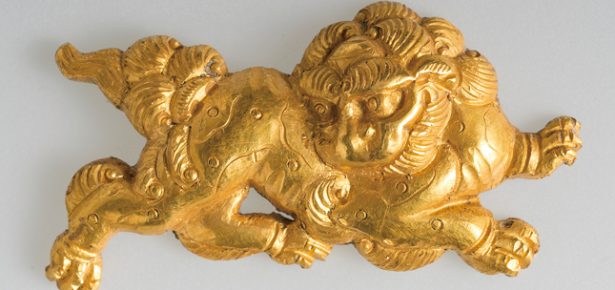
In 1573, the warlord Oda Nobunaga (1534-82) was determined to conquer the territories of rival military leaders and build a polity, which he referred to as the tenka or “all under heaven” (often translated as “the realm”), regardless of the opposition. Reading Medieval Ruins is about a thriving provincial city, Ichijōdani, that served as the headquarters of the Asakura warlords who ruled the province of Echizen. They resisted Nobunaga, and as a result, they and the city they had established were completely destroyed. A thriving community of more than 10,000 people, home to Buddhist temples and Shinto shrines, ceramics studios and textile dyers, a doctor’s office and a modest beaded rosary maker—all of this was destroyed by the armies of Nobunaga in the name of conquest.
The later account of the fall of the Asakura, the war tale Asakura shimatsuki or Chronicle of the Asakura, is filled with tales of a shameful military defeat, the subsequent harried retreat, and the massive slaughter that ensued. Nobunaga’s armies, having defeated the forces of the Asakura and chased them into their home province, turned to the burning of Ichijōdani and the killing of all civilians who could be captured. This ruinous moment is curious absent from almost all accounts of this significant decade in Japanese history. I argue that tales of the destruction of urban communities in premodern Japan’s past are either romanticized, as in the narrativization of the Genpei War in the Tales of the Heike, or are largely ignored, as is the case in the destruction of Ichijōdani, when the elimination of a city of 10,000 is seen simply as a bump on the road to reunification and, ultimately, peace under the Tokugawa.
Yet the archaeological evidence from Ichijōdani illuminates the daily lives of this late medieval community of provincial residents and resists the narrative that so many deaths were devoid of a larger meaning in the flow of Japanese history. The residents of this inland town, located along the Ichijō river just outside of the large flood plain of the Kuzuryū River—a basin that today is home to the bustling prefectural capital of Fukui—lived in a particular natural environment with a unique intersection of goods, commodities, and cultural networks. The ecology of their community was unlike those of other late medieval urban centers in Japan, and framed their experiences in life as well as the stark reality of their sudden deaths.
The Ichijōdani Asakura Family Site Museum contains an enormous collection of shards and objects excavated from the rural valley site that was once capital of the province. For more than 60 years, archaeologists and historians have labored in excavations across the valley as well as in archives and temples across the region to reconstruction the history of this disappeared community. Even a glance at the Museum’s online “Digital Archive” shows the beauty and power of the many intact and reconstructed historical treasures unearthed through their research: http://asakura-museum.pref.fukui.lg.jp/040_gallery/
A gold mythical lion (shishi) from a sword hilt (menuki) reminds us of the wealthy Asakura lords, their vassals, and the elite samurai visitors who came in and out of the valley for the century of its active use as a military headquarters. The beguiling fragment of a wooden Noh mask points to the deep networks of cultural patronage of the Asakura and other elite residents of the city, who invited poets, scholars, and performers from Kyoto and elsewhere in Japan to not just visit but take up residence in the city. And the wooden chess (shōgi) pieces, beloved by adults and children alike as a means of learning strategy, competing with friends, and wiling away the hours of a dark winter evening, serves to invoke the hours of leisure that were suddenly and coarsely snuffed out as part of Nobunaga’s plan to expand his own power.


Latest Comments
Have your say!